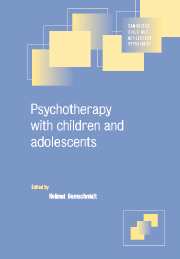Book contents
- Frontmatter
- Contents
- List of contributors
- Preface
- Part I Principles of psychotherapy with children, adolescents and families
- Part II Psychotherapeutic methods and settings
- Part III The practice of psychotherapy for specific disorders in childhood and adolescence
- 15 Anxiety disorders
- 16 Obsessive-compulsive disorder
- 17 Depressive syndromes and suicide
- 18 Dissociative [conversion] disorders
- 19 Disorders of sexual development and sexual behaviour
- 20 Substance abuse and addiction
- 21 Eating disorders
- 22 Psychotherapy in chronic physical disorders
- 23 Enuresis and faecal soiling
- 24 Dyslexia and dyscalculia
- 25 Stuttering
- 26 Hyperkinetic disorders
- 27 Autism
- 28 Schizophrenia
- 29 Conduct disorders, antisocial behaviour, delinquency
- 30 Physical abuse and neglect
- 31 Sexual abuse and sexual maltreatment
- Part IV The practice of psychotherapy in various settings
- Index
17 - Depressive syndromes and suicide
- Frontmatter
- Contents
- List of contributors
- Preface
- Part I Principles of psychotherapy with children, adolescents and families
- Part II Psychotherapeutic methods and settings
- Part III The practice of psychotherapy for specific disorders in childhood and adolescence
- 15 Anxiety disorders
- 16 Obsessive-compulsive disorder
- 17 Depressive syndromes and suicide
- 18 Dissociative [conversion] disorders
- 19 Disorders of sexual development and sexual behaviour
- 20 Substance abuse and addiction
- 21 Eating disorders
- 22 Psychotherapy in chronic physical disorders
- 23 Enuresis and faecal soiling
- 24 Dyslexia and dyscalculia
- 25 Stuttering
- 26 Hyperkinetic disorders
- 27 Autism
- 28 Schizophrenia
- 29 Conduct disorders, antisocial behaviour, delinquency
- 30 Physical abuse and neglect
- 31 Sexual abuse and sexual maltreatment
- Part IV The practice of psychotherapy in various settings
- Index
Summary
Definition and classification
As recently as 20 years ago, the issue of depressive syndromes in children was controversial. Many psychiatrists felt that children and adolescents lacked the cognitive and emotional capacity to develop depression. At most, the term ‘masked depression’ was used, where symptoms of some other disorder – usually anxiety or conduct disorder – were thought to reflect underlying low mood. Today, depression is generally recognized as an important psychiatric disorder, frequently occuring in children and adolescents (Beckham and Leber, 1995; Reynolds and Johnston, 1994).
The ICD-10 International Classification of Mental and Behavioural Disorders (WHO, 1992) assumes that the psychopathology of depression in childhood and adulthood is similar. As opposed to ICD-9 (WHO, 1978), aetiology and nosology of depressive syndromes are no longer addressed in ICD-10 (WHO, 1992). This development is based on the clinical findings that both the treatment with antidepressants and the use of specific psychotherapeutic methods are effective in treating ‘neurotic’ and ‘endogenic’ depression.
The diagnostic guidelines in ICD-10 distinguish recurrent bipolar affective disorders from unipolar affective disorders. Subclassification is based on the severity of the disorder. Persistent affective disorders are subdivided into cyclothymia and dysthymia. Milder forms of depression are also classified under ‘reaction to severe stress’ (‘brief’ and ‘prolonged’ depressive reaction).
Depressive disorder of conduct is the only form of depression specific to childhood. Recent theories propose that this disorder, classified as ‘mixed disorder of conduct and emotions’, differs from other depressive disorders in two distinct ways: first, with regard to familial predisposition and secondly, with respect to prognosis.
- Type
- Chapter
- Information
- Psychotherapy with Children and Adolescents , pp. 291 - 305Publisher: Cambridge University PressPrint publication year: 2001



